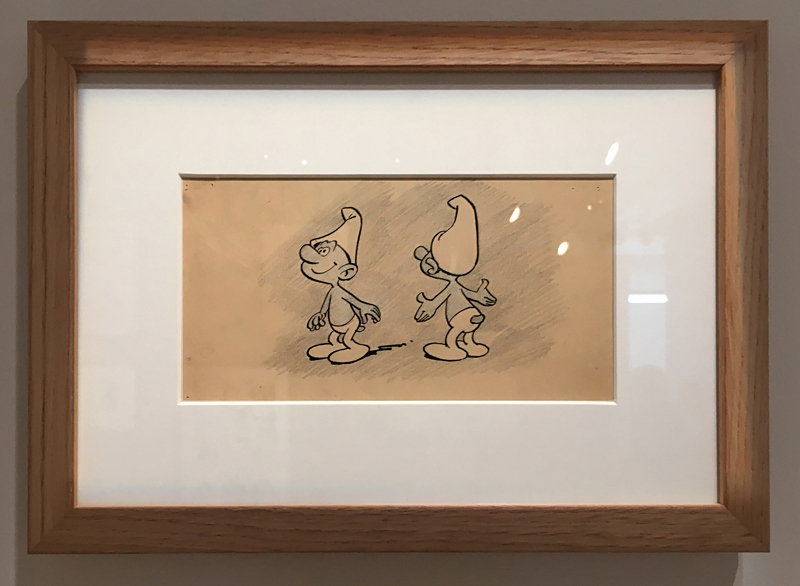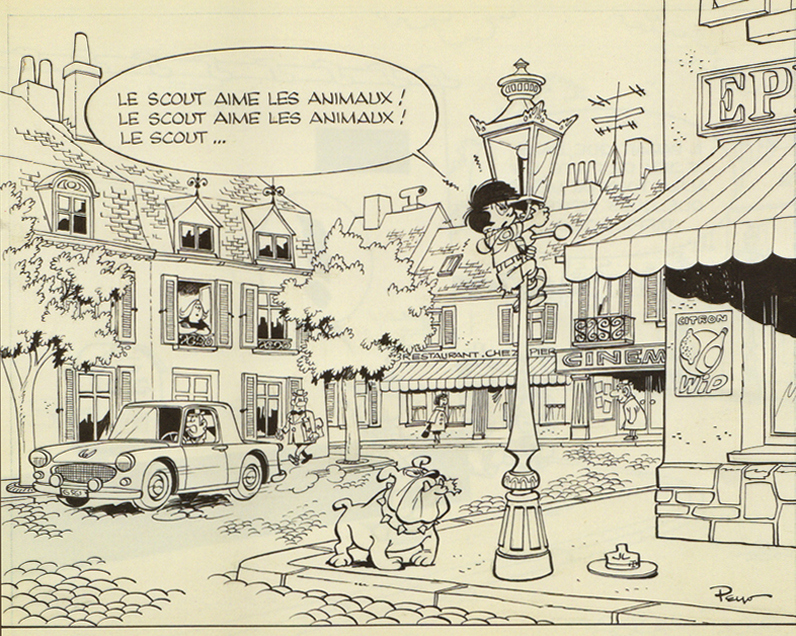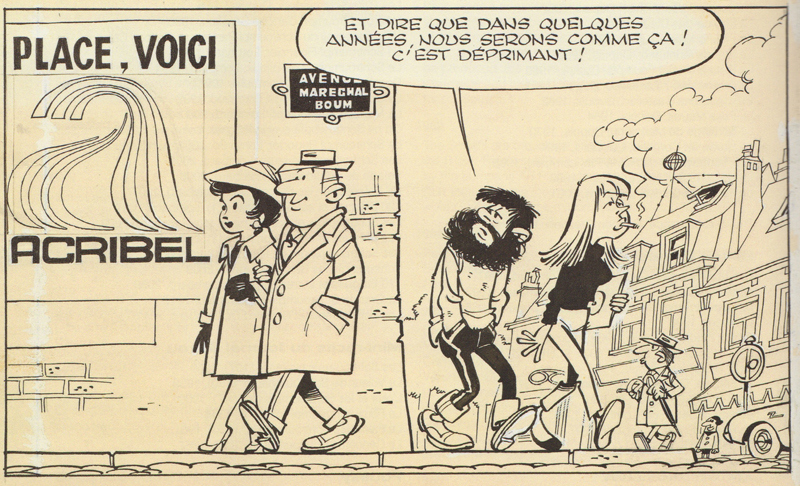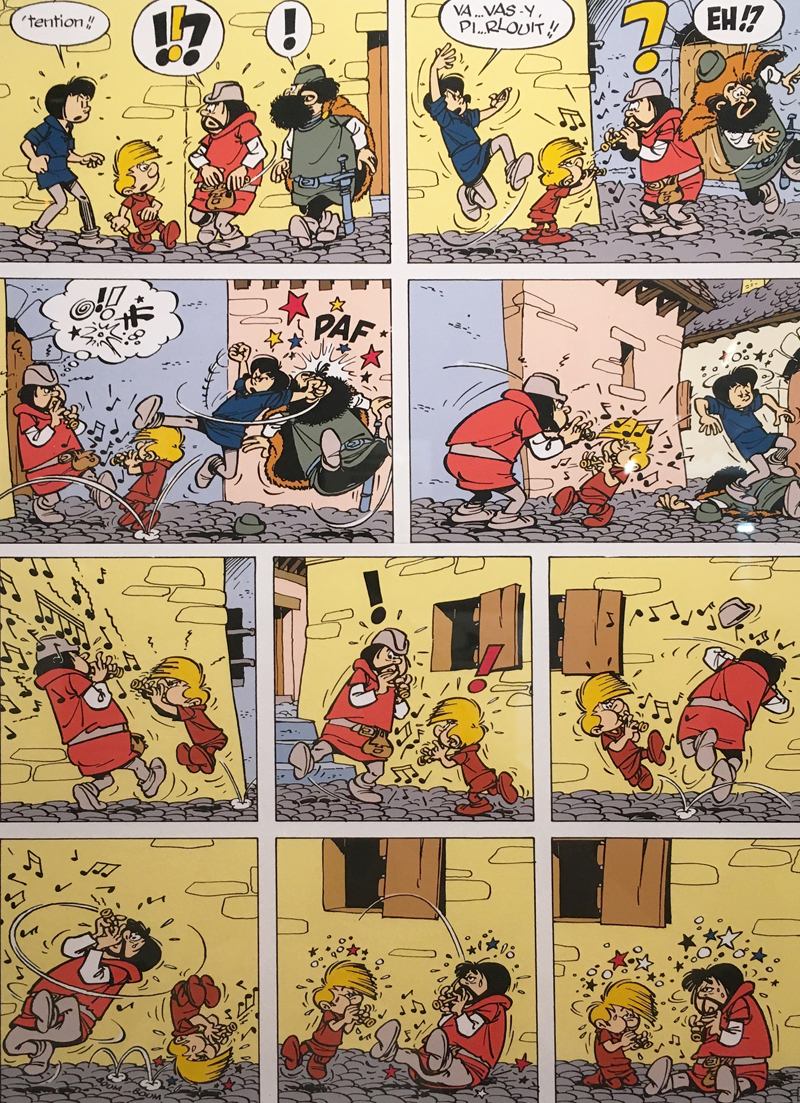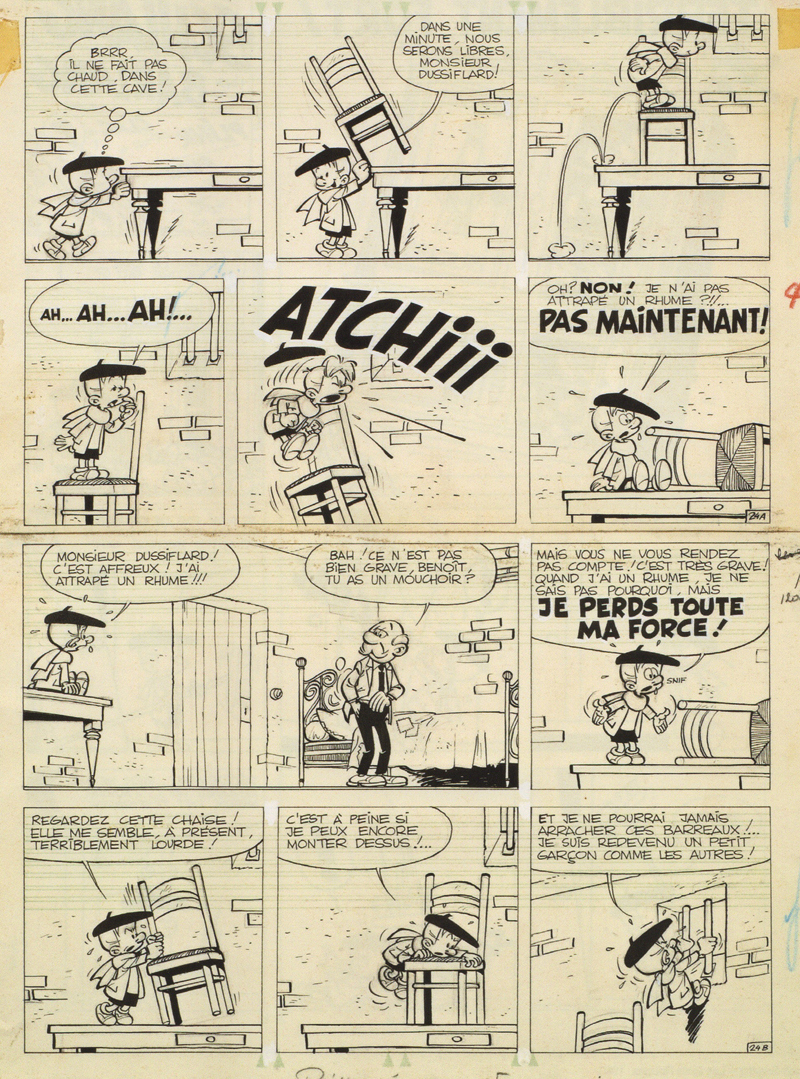After the Smurfs’ big debut, they might have been forgotten, had it not been for editor Yvan Delporte. Peyo had happily moved on to the Smurf-less Johan saga La Guerre des 7 fontaines (War of the Seven Fountains), but Delporte thought the blue elves could be useful. He wanted to plant a miniature magazine in the centerfold and Peyo’s tiny characters would make the perfect protagonists. The artist, a slow worker, agreed on one condition: Delporte had to help him with the story. Thus began a partnership which turned the Smurfs into stars.
Delporte’s mini-supplement was 1959’s Les Schtroumpfs Noirs (The Black Smurfs). It shows the imps turned against themselves by a mystery microbe, an insect-driven plague that blackens their bodies and their personalities. Given Belgium’s ongoing colonization of the Congo – echoed for years in its youth publications – this simplistic fable would later appear problematic. For export, it had to become The Purple Smurfs.
Today, Smurf lore is its own field of study. Yet few Franco-Belgian critics see Les Schtroumpfs Noirs as racist [1]. Within Peyo’s oeuvre, they focus more – and more justifiably – on incidents of sexism and anti-Semitism. Due to Yvan Delporte’s fervent love of sci-fi, the mini-story is cited as an early zombie apocalypse tale. Almost certainly Delporte had read Richard Matheson’s 1954 I Am Legend. This existential story of a germ-borne pandemic (spread via biting) inaugurated the genre. Delporte and Peyo’s horde of infected, black-as-night Smurfs – who, when contaminated, lose all the ability to communicate – certainly seem like its diminutive echo. Their cartoon even contains the same search for “scientific” solutions.
Delporte’s supplement proved a massive hit – so much so that the editor gave the Smurfs five more “minis.” Dupuis also started an animation house, TVA Dupuis, to put them on Belgian TV. For publicity, Spirou commissioned small figures in latex. By now Peyo had an intern called Gérard Deuquet. When the first Smurf figurines arrived, Deuquet was touched by his boss’s reaction. “The toys weren’t even painted and they were still all pink. But Peyo was over the moon, he was just like a little kid.” The artist lined all the statues up on his table. Then, grabbing a scalpel, he lopped off one figure’s tail and glued it in between its legs. The full-frontal Smurf had his intern in stitches.
Peyo was now one of Spirou‘s biggest names. Yet he had never forgotten who first published him. In 1963, the newspaper Le Soir decided to revive its post-War children’s supplement. The editors asked Peyo if he could revive Poussy, his 1949 series about a cat. Charles Dupuis, however, was now jealous of his star. If Poussy reappeared, he decreed, it had to be in Spirou. Peyo conceded, but he went on to draw a new series for Le Soir. This was Benoît Brisefer (Steven Strong), a European twist on the 1960s superhero phenomenon. Although Benoît possesses colossal strength, he is also just a child. When he catches a cold, his superpower vanishes.
A pint-sized existential loner in a beret, Benoît speaks and thinks like a grade school kid. Yet he is shunned by all the other children. He also has no family and lives alone in an empty house. As with several of Spirou‘s new series, this was not exactly boilerplate fare for youngsters. Yet Charles Dupuis loved it and he demanded to publish both Benoît and Poussy. With typical stubbornness, Peyo then created a third story for Le Soir. This one starred two adolescents, Jacky and Celéstin, but the art was handled by Willy Maltaite. Peyo was now producing four separate series, not to mention covers, illustrations, and Boy Scout calendars. This workload saw the inception of the “Studio Peyo”: a set of assistants he would employ for the rest of his life. Some of its participants were just starting out; others were highly experienced. But all of them worked to Peyo’s exacting specifications.
The first such associate was François Walthéry, who arrived in 1963. Since he was barely 17, Walthéry moved in with the Cullifords. He became close friends with Peyo’s son and daughter and, eventually, the artist’s lifelong pal. But as years went by, many other names would pass through Peyo’s doors: Roland “Gos” Goossens, Marc Wasterlain, Dérib (Claude de Ribaupierre), Lucien De Gieter, Daniel Desorgher, Roger Leloup, André Beniest, and Albert Blesteau.
Each discovered a boss with a paradoxical personality, for the artist was both insecure and hypercritical. Peyo once characterized his job as “like that of a playwright. When I’m writing, I enjoy myself enormously. But the production, the drawing itself, is more of a chore.” Although doubtful of his graphic skills, Peyo was unwilling – or unable – to delegate. Every passing year and each new success made him more and overextended.
The Smurfs’ first forty-page story, Le Schtroumpfissime (King Smurf) appeared in 1964. The female Schtroumpfette (Smurfette) followed in 1966. The same year, Peyo was approached by Kellogg’s, which wanted plastic Smurfs to put in its Corn Flakes boxes. The artist was so delighted he even drew all the ads. When this initiative ended, the figurines’ manufacturer – Germany’s Bully Figuren – got in contact, urging Peyo to start licensing them. Culliford approached Charles Dupuis as a partner but his publisher laughed at the idea. His company, Dupuis told Peyo, “didn’t sell plastic toys.” So Peyo took the plunge into merchandising alone. For all Smurf marketing, he was the sole beneficiary.
This decision radically changed his life. When François Walthéry had joined the Culliford household, only Peyo’s mother-in-law telephoned the studio. But, within a year, their phone was ringing off the hook. Peyo spent hours and hours every day on marketing. He started working at night, when things were quieter, and tried to compensate with naps after lunch. To meet his many deadlines, this meant repeated all-nighters. But, as Jean Roba put it, “Back then, if you needed help, you could phone anyone. You could ask at any hour, time didn’t matter.”
The human support system anchored more than Peyo’s work; these friendships mattered very deeply to him. Even the Smurfs’ world, he felt, reflected them. “Me, Jijé, Franquin, Morris, Roba, Yvan, Tillieux… we were a gang. We saw each other all the time and it wasn’t just for work. It was more about the sheer pleasure of being together.”
Peyo’s home studio was packed with distractions. In addition to taking calls, Culliford would stop to play with his children or shoot the breeze with colleagues. Yvan Delporte would appear, stash his bottle of Coke in the fridge, then stretch out on the studio floor “to think.” All these routines affected Peyo’s deadlines and he was infamous for chronic tardiness. Although he lived a forty-minute drive from Dupuis’s printer, Peyo always delivered his boards there – at dawn.
This extreme schedule endured for half a decade. In 1968, recalls François Walthéry, “Delporte and Peyo would give me the work on Monday morning; it was due Tuesday. I would finish around three am and Nine would color the boards. Somewhere near four o’clock, we’d all climb into Peyo’s Taurus. We’d take the boards to Yvan, so he could photocopy them. Then we’d all drive out to the printer. Once we were finally back, we’d get a steak at this place called the Saphir.”
But, in 1968, Spirou‘s charmed world imploded. After two decades, Franquin gave up drawing the trademark series Spirou and Fantasio. Despite his thirteen years of service, Yvan Delporte was fired. Then, Morris left – taking Lucky Luke with him to Pilote magazine. Peyo, who had venerated Morris almost as much as Hergé, was stunned by the defection. Coming home from a movie, Walthéry found him in tears. “Peyo met me at the door and he was so agitated! All he could say was, ‘Do you know who’s left us?” Walthéry thought one of their close friends had died.
The night before his forty-first birthday, Peyo had a heart attack. The doctors demanded an end to his bohemian lifestyle – and they put him in bed for a month. To cheer him up, Yvan Delporte deployed a special remedy: an X-rated version of Johan et Pirlouit. This was a collaboration between two dozen artists and, every day, Peyo received a new installment. The cavalcade of topless princesses and Smurfs with erections helped take the cartoonist’s mind off his health.
Meanwhile, the Smurfs were flourishing. In 1969, a cookie company sponsored their album Le Cosmoschtroumpf, which was followed by one for Kwatta chocolate (L’Apprenti Schtroumpf, in 1970). Peyo did these in between his usual Spirou series: 1968’s Les Schtroumpfs et le Cracoucass (The Smurfs and the Howlibird) and 1973’s Schtroumpf vert et vert Schtroumpf. By the early ’70s, he was at work on a big-screen animation project. It was produced by Belvision, a local firm known for cartoon films that starred Tintin, Asterix, and Lucky Luke. Since Belvision was owned by Tintin’s publisher, however, Charles Dupuis signed on to co-produce.
For his cinema debut, Peyo chose to adapt an existing tale. He re-told the fifteen-year-old story of Peewit’s magic flute, in which the Smurfs made their first-ever appearance. With Delporte handling the music, Peyo spent two years on the piece. It was almost 1976 when La Flute à Six Schtroumpfs finally opened in Belgian cinemas. Five years had passed without a new Johan album and three without Peyo’s art appearing in Spirou.
He tried to rectify that in 1976, with a story called La Soupe aux Schtroumpfs (Smurf Soup). But this time, things proceeded at a glacial pace. Peyo’s new assistant, Albert Blesteau, worried about him. “He was taking one pill to sleep and a different one to wake up.” The night before a German toy fair, Peyo’s ulcer hemorrhaged. While an emergency transfusion saved his life, it also left the artist with hepatitis – then diabetes. Cartoonist Frédéric Jannin, a friend of Peyo’s son, paid him a visit in hospital. Jannin was astonished when Peyo told him, “I have to get out of here, I don’t have the time to die.”
Marked by his early struggles, Peyo had never turned down work. But at the very moment this almost killed him, it also paid an unexpected dividend, when something happened that would become Peyo’s personal myth. One of their Smurf licensees was a chain of English service stations, where the toys happened to catch a US visitor’s eye. On the spot, he decided to import the miniatures. His statuettes were so successful they led to stuffed Smurf toys. One of these was purchased by NBC’s Fred Silverman, then presented to his grand-daughter as a gift. Struck by the child’s utter devotion to her plaything, the network director decreed he had to have the Smurfs.
In fact, Silverman had already heard from Dupuis about licensing. Whether or not his grand-daughter ever played a role, he made the decision to speak with Hanna-Barbera. When the pair sat down to negotiate, they were face-to-face with the Dutchman Freddy Monnickendam. Monnickendam was a sales specialist hand-picked by Charles Dupuis. In 1981, after two years of talks, he concluded a deal between the Dupuis, NBC, and Hanna-Barbera. In almost every sense, this agreement was good for Peyo. It gave Dupuis all the distribution rights in non-Anglophone countries. Additionally, any time the series topped American charts, NBC was obligated to commission a brand-new season. Peyo had approval and veto power over all the scripts.
Between 1981 and 1990, Hanna-Barbera made 256 episodes. The Smurfs (syndicated as Smurfs’ Adventures) were sold in forty-seven countries. Although Peyo’s rights had been well-defined, there was a stumbling block: he spoke no English. Delporte, fluent in the language, was his translator. But from the start, the disagreements were deep. “One key problem,” said Delporte, “was motive. The Americans might envision a Smurf inheriting money, which then filled the other Smurfs with envy. Or they would picture a Smurf finding some treasure and these riches causing problems in the village. Or a Smurf would try and sell Papa Smurf’s secret formula. Everything they proposed, every plot, revolved around money.”
Peyo tried explaining that, for his characters, gain and greed were not even concepts. But these explanations were received as unthinkable. Says Delporte, “All they did was mutter behind Peyo’s back. The view was, ‘This is all so sweet it’s giving me cavities.'” At the height of their success, Peyo and Hanna-Barbera were largely speaking through lawyers. When Peyo found the studio was working behind his back, things got even worse. The artist fought back by vetoing scripts en masse, Hanna-Barbera fell behind with NBC, and, in a panic, everyone looked to Delporte. However, by then, Peyo was also at odds with him.
While the artist wrestled with American-style fame, the house where he built his career disappeared. In 1985, after a long management crisis, Dupuis was sold to a set of linked entities: Groupe Brussels Lambert, Hachette Livre, and Editions Mondiale. The first two acquired its publishing and media rights, and Peyo suddenly found himself working for virtual strangers. Now, trying to maintain control meant constant travel; rarely did the old gang of artists ever see each other. Peyo’s regime became so punishing even his mental state began to suffer. Jean Roba remembered his tearful phone calls. “Peyo was the motor of this giant locomotive, travelling at top speed and pulling a whole crazy train… and he no longer even knew how to stop.” Franquin put it differently: Peyo’s blue creations had “eaten him alive.”
Yet the Smurfs’ global grip only tightened. In 1984, their twelfth album, Le Bébé Schtroumpf (Baby Smurf), earned its author a fortune. A year later, Peyo sought tax relief by moving to Switzerland. Culliford devolved Studio Peyo to his son, Thierry, and the Smurfs’ management to his daughter, Veronique. The artist still owed Dupuis one final album and, in 1988, he completed and delivered Les P’tits Schtroumpfs (The Little Smurfs). The next year, working with all-new assistants, he tried to replicate the Spirou he had known, by launching the first issue of a Smurfs magazine. But magazines based around cartoons were now in decline. Their market had been eaten away at by full-length comic books and also television.
Peyo’s biggest project was a French theme park called Le Big Bang Schtroumpf. He had licensed his characters to a conglomerate called Sorepark, charged with reviving an old industrial site. But, after a bumper opening, their recipe failed. Within a year, the park had lost 104 million French francs (around $18 million) and, by 1990, it was bankrupt. Sorepark ceded management to the Belgian Walabi Group, which in turn lost its right to use the Schtroumpfs in 1992.
Peyo kept putting out albums into the 1990s. But his son Thierry struggled to distribute them. Looking for a new start, he and Peyo signed with Les Editions du Lombard – the publishing arm of Spirou‘s old rival Tintin. His contract obligated Peyo to produce four new books a year, but that was only the Smurfs. The artist also signed for three Johan volumes and two for Benoît Brisefer. The first to appear, in 1991, was Le Schtroumpf Financier (The Financial Smurf). It was a collaboration between Peyo and Thierry.
Le Schtroumpf Financier was very well received. Yet it had tested Peyo’s now-fragile strength. On Christmas Eve, 1992, he died of a heart attack. Culliford was 64.
Peyo’s career was so fantastic it might have come from one of his sorcerers. But the formula was less mysterious than it might seem. Just take one highly specific moment in time, add a crew of eccentric virtuosos, then marinate in hour-by-hour, day-by-day, night-by-night proximity. Throw in gallons of sweat and the strain of dealing with exigent editors, tight deadlines, and a strict, old-fashioned code of behaviour. The resulting innovations sprang nonetheless from sheer enjoyment. Almost as humble as they were audacious, Spirou‘s all-time greats took success with a grain of schtroumpf. Theirs was an all-too-human brand of creativity – one hard to equal in our virtual world.
Many testaments to it exist, including one from André Franquin. Along with Peyo, Jean Roba, and Maurice Tillieux, he was being honored at a French book fair, and in order to reach more children, the organizers had scheduled their last appearance of the day at a circus. The tired cartoonists were seated under its teeming big top when, in the words of Franquin, “All the music suddenly stops and this voice booms out, ‘There are four of them and you know them well! You know they’re hilarious! Every week, they make you laugh until you cry! So, without further ado…’ The crowd is going wild so, pasting on our modest smiles, we start to lift our sagging bottoms out of the chairs – just in time to see four chimpanzees bound into the ring. Here are the real professionals! They can juggle! They can balance plates! … They’re a total treat!”
“After the monkeys,” said Franquin, “it was our turn.“
With thanks from the author to the Centre Wallonie-Bruxelles, to exhibition curators José Grandmont and Hugues Dayez (author of the excellent biography Peyo l’Enchanteur) and to François Walthéry. Also recommended: François Ayroles’ cartoon masterpiece Moments Clés du Journal de Spirou (Dupuis, 2018), available both in print and as an e-book.
First published on The Comics Journal. Cynthia Rose is a British writer, author, and broadcaster based in Paris. Her writings can be found on www.muchacreative.paris.
[1] For one thing, as art historian André Gunthert notes, one visual element “significantly contradicts” a racist interpretation: “Within 1960s Franco-Belgian comics, representations of Africans conform to a stereotype from colonial tradition, one that requires not only a dark skin color but also fleshy lips and a pidgin speech pattern known as ‘petit nègre‘, such as that found in Tintin in the Congo and Asterix. … Graphically, the Schtroumpfs noirs bear neither the signature of the colonial tradition nor the characteristics permitting recognition of a supposed ‘Africanité.'” One should add that in 1959, when the book first appeared, Belgium’s colonial enterprise had not reached its end. It was 1960 when the country granted independence to the Democratic Republic of the Congo; protectorates Rwanda and Burundi gained theirs two years later. With this colonial legacy, Belgian “ethnic” caricatures were never anodyne. But Gunthert is right to note that exporting Les Schtroumpfs noirs to the US gave the story a different context. There, it appeared within traditions – and hostilities – born of American slavery. This necessarily altered both the understanding of “noir” and Peyo’s portrayal of aggressive black Schtroumpfs.
© Cynthia Rose, all rights reserved. Header image: Benoît Brisefer © Culliford & Garray / Le Lombard
